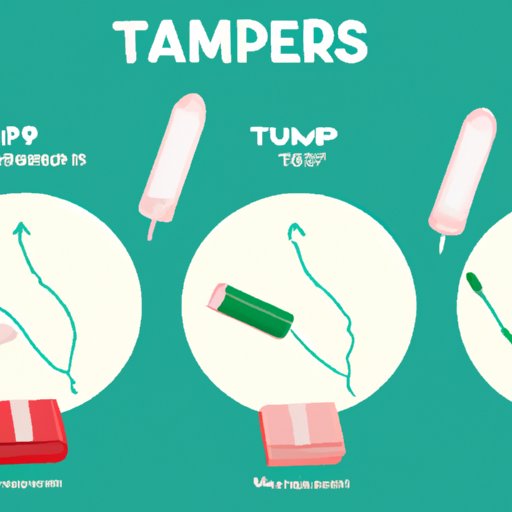Introduction
For many people, the idea of using a tampon can be intimidating. The thought of putting a foreign object into your body can be scary and uncomfortable. However, tampons are a convenient and popular menstrual product for a reason. They allow for greater freedom of movement and can be more discreet than pads. That’s why we have created this comprehensive guide to putting in a tampon successfully.
We will cover all aspects of using tampons, including step-by-step instructions, product comparison, tips and tricks, common mistakes to avoid, and hygiene practices. By the end of this article, you will feel confident and comfortable using tampons regularly.
Step-by-Step Guide
The following is an easy-to-follow list to help you insert a tampon:
- Wash your hands with soap and water.
- Unwrap the tampon and familiarize yourself with the components: the tampon itself and the applicator (if the tampon has one).
- Relax your muscles. Spreading your legs and taking a deep breath can help.
- Insert the tampon into your vagina. Aim towards your lower back, at a 45-degree angle.
- Push the tampon in until only the string is visible. Make sure the tampon is comfortable and snug.
- Dispose of the applicator if the tampon has one. It is important never to flush anything but toilet paper down the toilet.
It is important to note that you cannot get stuck using a tampon. The cervix (the opening to your uterus) is not large enough to allow a tampon to pass through. If you have difficulty inserting the tampon, try repositioning it or lubricating the tip with a water-based lubricant. If you still cannot insert it comfortably, try a smaller size or consider seeing a doctor to rule out any underlying medical conditions.
Visual Tutorial
For visual learners, we have included a series of clear, easy-to-follow images that demonstrate each step involved in inserting a tampon. Follow along with the images and instructions to ensure proper tampon insertion.

Comparison of Products
There are a variety of tampon products available on the market, including different types of applicators (plastic, cardboard, or no applicator), sizes, and brands. Here are some pros and cons for each type of tampon:
- Plastic applicators: easy to use, slip in smoothly, and can be inserted without much discomfort. Also, a great option for beginners. However, they are not environmentally friendly and can be more expensive than other options.
- Cardboard applicators: eco-friendly, often cheaper, and flushable. Unfortunately, they can be more difficult to insert and may cause discomfort if not lubricated properly.
- No applicator: the most environmentally friendly option, cost-effective, and also suitable for those with a heavy flow. But, they can be difficult to use, require clean hands, and may cause some discomfort.
It is important to choose tampons based on personal preference and needs. Experiment with a few different types of tampons to find the one that works best for you.
Tips and Tricks
Here are some tips and tricks for individuals who may be struggling to insert a tampon or for beginners:
- Try different positions. Sitting on the toilet or squatting can make tampon insertion more comfortable.
- Relax your muscles. Take several deep breaths before attempting to insert the tampon. Tensing your muscles can cause discomfort.
- Use lubricant. A water-based lubricant can make insertion smoother and easier.
Always use the smallest size tampon that can accommodate your flow. A larger tampon can be uncomfortable or difficult to insert.
Common Mistakes to Avoid
Here are some common mistakes that individuals may make while attempting to insert a tampon:
- Not inserting the tampon far enough. This can cause discomfort and may not provide adequate protection.
- Inserting at the wrong angle. Remember to aim toward the small of your back at a 45-degree angle.
- Using an uncomfortable size. Using a tampon that is too big can make insertion uncomfortable or even painful.
Take your time and make sure to follow the instructions provided to avoid these common mistakes.
Hygiene Practices
Proper hygiene practices are crucial when using tampons. Here are some important tips:
- Change your tampon every 4-8 hours, depending on your flow. Leaving a tampon in for too long can increase the risk of Toxic Shock Syndrome (TSS).
- Always wash your hands with soap and water before inserting or removing a tampon.
- Wrap the used tampon in tissue and dispose of it in the trash. Never flush a tampon down the toilet.
- Keep the vaginal area clean and dry to prevent infection. Do not use scented products or douches, as they can disrupt the natural pH balance of the vagina.
It is essential to maintain proper hygiene when using tampons to avoid infections and other health issues.
Conclusion
In conclusion, using tampons can be intimidating, but it doesn’t have to be difficult. By following the step-by-step instructions, using a visual tutorial, and taking advantage of helpful tips and tricks, you can insert a tampon confidently. Remember to choose the right tampon for your needs, avoid common mistakes, and practice proper hygiene practices. With this comprehensive guide, you can enjoy the freedom and convenience that tampons offer during your menstrual cycle.
